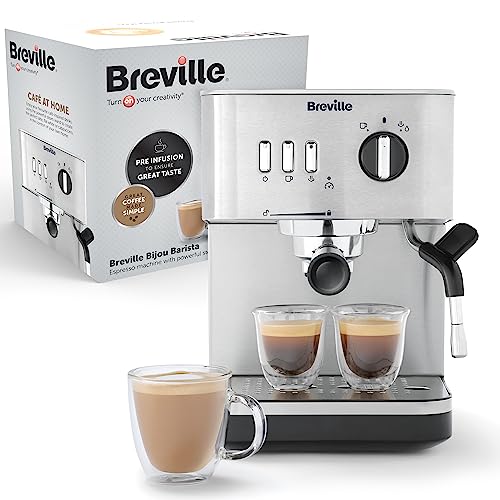How to Build a Professional Espresso Machine
This is an excellent choice for cafes and coffee shops that wish to attract customers who are enthusiastic about barista and espresso. It's the official machine of the World Barista Championships and it truly shows.
It comes with a water reservoir so that the barista just needs to refill it once during their shift. The machine also comes with steam wands that cool-touch as well as hot water taps for tea.
Water
A commercial espresso machine must be able of producing a large volume of espresso-based drinks efficiently. They are typically made of stainless steel, which is strong and resistant against breaks and scratches. These espresso machines are also easy to maintain and clean.
A top-quality machine should include a separate shut-off valve to the water pipe in order to prevent limescale build-up. This will ensure that any repairs are confined to the specific machine components and won't impact the rest of your operation.
When selecting the water you want to drink ensure that you test it and treat it correctly to ensure the best results. You can remineralize distilled water by adding a few minerals. This can reduce its negative erosive properties and enhance its taste, however it could also harm certain machines. The remineralized wate will make the boiler sensor believe that the machine is full, even though it isn't. This can cause the machine to overheat and be damaged.
Grinder
The grinder is a vital element of a successful espresso machine. It is used to take a raw, unground bean and turns it into a finely ground coffee that can be put into the filter basket to produce an excellent extraction.
Commercial-grade professional machines include a grinder that can be programmed to work with different sizes of drink. This guarantees the same results every time. Super-automatic machines go a step further and automatize the entire process from brewing through grinding and dispensing. These types of machines typically get high marks in Lab tests due to their hands-free simplicity of use.
A manual or semi-automatic espresso machine requires more involvement by the barista, but the quality of the final product is often worth it. This model earned an 2022 Good Housekeeping Coffee Award for its clever dosing feature that weighs and dispensing the correct amount of ground coffee every time. It also comes with a low pressure pre-infusion for well-balanced extraction, as well as the milk frother produced dense, thick steamed milk during our tests.
Temperature
When it is time to make espresso, temperature plays a major factor in the taste and quality of your shots. If the water temperature is not at a suitable level, it may result in the extraction being impeded and may even result in an unpleasant cup.
Fortunately, high-quality espresso machines have tools that allow you to ensure that your water is at the right temperature. One way to do this is with PIDs, which monitors and adjusts the temperature of the water. Double boiler systems are another way to achieve this. This lets you utilize one boiler for tea and steam, while the other heats water to brew temperatures.
Carles mentions that these types of systems can make a big difference for large businesses and baristas working at home. They can aid novices get the perfect espresso shot since they maintain an exact temperature while avoiding many variables that can affect the flavor quality. It's also easier for baristas with more experience to get their espressos just how they prefer.

Pressure
The pressure an espresso machine is using also affects the quality of coffee it produces. Many espresso drinkers have observed that their drinks taste different based on the amount of pressure used, even if all other factors are constant.
In general, commercial-grade machines utilize nine bars of pressure to make espresso. These machines are also more likely to be steam driven than pump-driven. Although higher-pressure machines are available they generally require a more sophisticated group head design to manage the higher pressure levels.
While you may see some espresso machines advertising 15 or even 18 bars of pressure, nine bars are generally regarded as the most reliable standard for producing consistently excellent espressos. These machines that are higher pressure are generally less expensive and are intended for home use.
To put 9 bars of pressure in perspective, it's nearly four times the amount of pressure which is emitted by the air in your car tire. The greater the pressure a professional espresso maker can apply, then the more effective it is at separating flavor from the coffee beans you love. For this reason, it's worth investing in a premium machine that can deliver the highest quality results.
Barista Skills
A barista should be able to take and process customer orders quickly and accurately. This is particularly important during busy times at the coffee shop. A good customer service skill is crucial for establishing relationships with customers and boosting sales for the coffee shop. This includes recognizing frequent customers, working efficiently to resolve issues and remaining friendly and positive in challenging circumstances.
Baristas are often adept at multitasking as they are expected to take orders, operate a cash register, communicate orders with coworkers, and answer telephone calls at the same time. This skill allows the customer to enjoy an enjoyable experience at the coffee shop by ensuring that orders are served quickly.
It is essential for a barista's knowledge to be able to make different types of drinks using an espresso machine. Learn about the various types of espresso by studying about their characteristics, tasting them in person, or watching online videos. Many baristas find it helpful to attend classes offered by various organizations.
